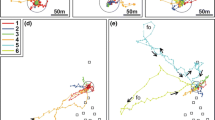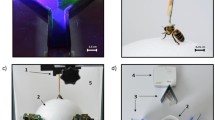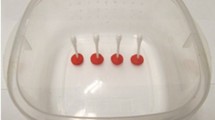Summary
In order to explore how honeybees manage to retrieve the right landmark-memory in the right place, we trained bees along a short foraging route which consisted of two identical huts 33 m apart. Bees entered each hut to collect a drop of sucrose on the floor. The location of the drop was defined by the same arrangement of four blue and yellow cylindrical landmarks. However, in one hut the drop was between two yellow cylinders and in two other it was to the east of the blue cylinders. On tests with the sucrose missing, bees tended to search in the appropriate area in each hut (Fig. 1), thus showing that they used cues other than the sight of the local landmarks to select the appropriate memory.
In a second experiment, the position of the sucrose was specified by yellow cylinders in one hut and by blue triangles in the other. When the arrays were swapped between huts, bees searched in the position specified by the array they encountered (Fig. 2). Thus, memories can be triggered by visual features of local landmarks.
Bees were also trained outside to collect food from two platforms 40 m apart. The location of sucrose on one platform was defined by yellow cylinders, and on the other it was defined by blue triangles. When these arrays were exchanged between platforms, bees searched on each platform as though the landmarks had not been swapped. It seems that the more distant surroundings, which fill most of the visual field, may be more potent than the local landmarks in deciding which memory should be retrieved.
It is argued that one role of distant landmarks and other contextual cues is to ensure that bees retrieve the correct memory of a constellation of local landmarks while the bees are still some distance away from their goal. Even at a short distance, a bee's current image of local landmarks may differ considerably from its stored representation of those landmarks as seen from the goal. Accurate recall of the appropriate memory will be more certain if it is primed by relatively distant landmarks which present a more constant image as a bee moves in the vicinity of its goal.
Similar content being viewed by others
References
Bogdany FJ (1978) Linking of learning signals in honey bee orientation. Behav Ecol Sociobiol 3:323–336
Burkhalter A (1972) Distance measuring as influenced by terrestrial clues inCataglyphis bicolor. In: Wehner R (ed) Information processing in the visual systems of arthropods. Springer, Berlin Heidelberg New York, pp 303–308
Cartwright BA, Collett TS (1982) How honeybees use landmarks to guide their return to a food source. Nature 295:560–564
Cartwright BA, Collett TS (1987) Landmark maps for honeybees. Biol Cybern 57:85–93
Cheng K, Collett TS, Pickhard A, Wehner R (1987) The use of visual landmarks by honeybees: bees weight landmarks according to their distance from the goal. J Comp Physiol A 161:469–475
Gould JL (1987a) Landmark learning by honey bees. Anim Behav 35:26–34
Gould JL (1987b) Honey bees store learned flower-landing behaviour according to time of day. Anim Behav 35:1579–1581
Heinrich B (1976) Foraging specializations of individual bumble bees. Ecol Monogr 46:105–128
Janzen DH (1971) Euglossine bees as long-distance pollinators of tropical plants. Science 171:203–205
Lindauer M (1960) Time-compensated sun orientation in bees. Cold Spring Harbor Symp Quant Biol 25:371–377
Rumelhart DE, McClelland JL (1986) Parallel distributed processing, vol 1. M.I.T. Press, Cambridge, Mass
Wehner R, Raeber F (1979) Visual spatial memory in desert ants, genusCataglyphis (Formicidae, Hymenoptera). Experientia 35:1569–1571
Wehner R, Srinivasan MW (1981) Searching behaviour of desert ants, genusCataglyphis (Formicidae, Hymenoptera). J Comp Physiol 142:315–338
Wehner R, Harkness RD, Schmid-Hempel P (1983) Foraging strategies in individually searching antsCataglyphis bicolor (Hymenoptera: Formicidae). (Acad Wiss Literatur, Mainz) Fischer, Stuttgart New York
Author information
Authors and Affiliations
Rights and permissions
About this article
Cite this article
Collett, T.S., Kelber, A. The retrieval of visuo-spatial memories by honeybees. J. Comp. Physiol. 163, 145–150 (1988). https://doi.org/10.1007/BF00612004
Accepted:
Issue Date:
DOI: https://doi.org/10.1007/BF00612004




